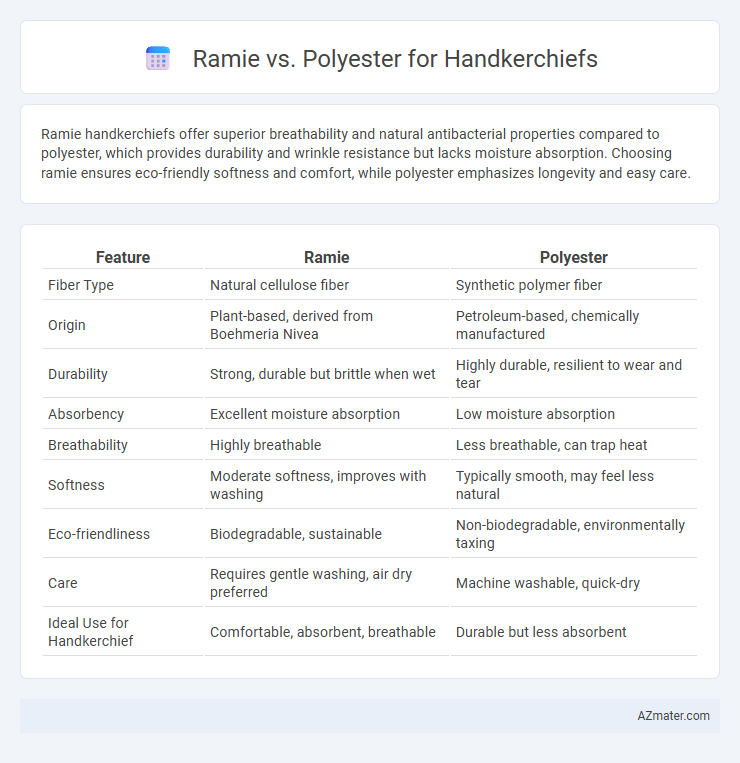Ramie handkerchiefs offer superior breathability and natural antibacterial properties compared to polyester, which provides durability and wrinkle resistance but lacks moisture absorption. Choosing ramie ensures eco-friendly softness and comfort, while polyester emphasizes longevity and easy care.
Table of Comparison
| Feature | Ramie | Polyester |
|---|---|---|
| Fiber Type | Natural cellulose fiber | Synthetic polymer fiber |
| Origin | Plant-based, derived from Boehmeria Nivea | Petroleum-based, chemically manufactured |
| Durability | Strong, durable but brittle when wet | Highly durable, resilient to wear and tear |
| Absorbency | Excellent moisture absorption | Low moisture absorption |
| Breathability | Highly breathable | Less breathable, can trap heat |
| Softness | Moderate softness, improves with washing | Typically smooth, may feel less natural |
| Eco-friendliness | Biodegradable, sustainable | Non-biodegradable, environmentally taxing |
| Care | Requires gentle washing, air dry preferred | Machine washable, quick-dry |
| Ideal Use for Handkerchief | Comfortable, absorbent, breathable | Durable but less absorbent |
Introduction to Ramie and Polyester Handkerchiefs
Ramie handkerchiefs, made from natural fibers derived from the stalks of the flowering plant Boehmeria nivea, offer exceptional breathability, moisture-wicking properties, and a smooth texture ideal for sensitive skin. Polyester handkerchiefs, crafted from synthetic polymers, provide durability, wrinkle resistance, and quick-drying capabilities, making them low-maintenance and long-lasting. Comparing ramie and polyester highlights the trade-offs between natural, eco-friendly materials and synthetic fibers optimized for performance and convenience in everyday use.
Origins and Production Processes
Ramie, a natural fiber derived from the stalks of the Chinese nettle plant, undergoes a labor-intensive decortication process to separate the fiber from the woody core, emphasizing its eco-friendly origins. Polyester, a synthetic fiber produced through polymerization of petrochemicals like ethylene glycol and terephthalic acid, relies on energy-intensive industrial processes for its creation. The natural, biodegradable characteristics of ramie contrast sharply with the petrochemical dependence and durability-focused production of polyester in handkerchief manufacturing.
Physical Characteristics Comparison
Ramie fibers are natural, lightweight, and highly absorbent, providing a crisp texture and excellent breathability, making them ideal for handkerchiefs used in hot climates. Polyester is a synthetic fiber known for its strength, wrinkle resistance, and quick-drying properties, yet it lacks the moisture-wicking capability and softness of ramie. The durability of polyester handkerchiefs surpasses that of ramie, but ramie's biodegradability and natural feel offer a more eco-friendly and comfortable option.
Moisture Absorption Abilities
Ramie handkerchiefs exhibit superior moisture absorption due to their natural fiber composition, which allows them to wick away sweat and moisture efficiently. Polyester, a synthetic fiber, has low moisture absorption and tends to repel water, making it less effective at managing perspiration. Choosing ramie for handkerchiefs ensures better comfort and dryness in humid or hot conditions.
Breathability and Comfort
Ramie handkerchiefs offer superior breathability due to their natural cellulose fibers, which allow better air circulation and moisture absorption compared to polyester. Polyester, being a synthetic fabric, tends to trap heat and moisture, resulting in less comfort during extended use. The natural texture of ramie feels softer on the skin, enhancing comfort, whereas polyester can cause irritation or discomfort due to its non-breathable nature.
Durability and Longevity
Ramie fiber offers superior durability and longevity for handkerchiefs due to its natural strength and resistance to wear and tear, maintaining its shape and texture over extended use. Polyester, a synthetic fabric, is highly durable, resisting shrinking and stretching, and retains color well, making it a long-lasting option for handkerchiefs. While both materials excel in durability, ramie's natural breathability and biodegradability provide added environmental benefits compared to polyester's synthetic composition.
Environmental Impact and Sustainability
Ramie, a natural fiber derived from the stalks of the Chinese grass plant, is biodegradable and requires fewer pesticides and water compared to cotton, making it environmentally sustainable for handkerchief production. Polyester, a synthetic fiber made from petrochemicals, contributes to non-biodegradable waste and microplastic pollution, posing significant environmental challenges. Choosing ramie over polyester reduces carbon footprint and supports eco-friendly textile practices in the handkerchief industry.
Maintenance and Care Requirements
Ramie handkerchiefs require gentle washing with mild detergents and air drying to maintain their natural luster and prevent fiber damage, while polyester handkerchiefs are more durable, machine washable, and quick drying, making them low maintenance. Ramie fibers are prone to shrinking and wrinkling, demanding careful handling during laundering, whereas polyester resists wrinkles and shrinking, offering easy care. For longevity, ramie benefits from avoiding high heat settings in drying and ironing, whereas polyester tolerates higher temperatures without degradation.
Cost Comparison
Ramie handkerchiefs generally cost more than polyester due to the natural fiber's labor-intensive harvesting and eco-friendly properties, which increase production expenses. Polyester handkerchiefs, made from synthetic fibers derived from petroleum, are cheaper to produce and thus retail at lower prices, offering a budget-friendly option. Consumers seeking durability and cost-efficiency often prefer polyester, while those valuing natural materials may accept the higher price of ramie.
Choosing the Right Handkerchief Material
Ramie handkerchiefs offer superior breathability and natural moisture absorption, making them ideal for sensitive skin and eco-conscious consumers. Polyester handkerchiefs provide durability, wrinkle resistance, and vibrant color retention, suited for frequent use and easy maintenance. Selecting the right handkerchief material depends on balancing comfort and practicality, with ramie excelling in softness and sustainability, while polyester ensures longevity and low upkeep.

Infographic: Ramie vs Polyester for Handkerchief
 azmater.com
azmater.com